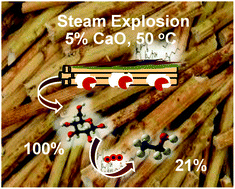Mechanism of lignocellulose modification and enzyme disadsorption for complete biomass saccharification to maximize bioethanol yield in rapeseed stalks†
Abstract
Rapeseed stalk provides an enormous biomass resource for bioethanol production, but its characteristic recalcitrance towards catalysis results in inefficient cellulose hydrolysis, with lower bioethanol yield compared with other major crop straws. Based on our previous analyses of large populations of rapeseed samples, in this study we selected three rapeseed stalks that showed distinct cell wall composition, and then performed steam explosion followed by mild chemical pretreatment to reduce the recalcitrance to lignocellulose degradation. As a result, three typical pretreatments were established to extract cell wall polymers (hemicelluloses, lignin, pectin) and also to specifically reduce the degree of polymerization of the β-1,4-glucans, leading to a remarkable increase in biomass porosity and cellulose accessibility in rapeseed stalks. Notably, steam explosion with mild CaO pretreatment (50 °C) generated an optimal lignocellulose substrate that was effective for almost complete enzymatic saccharification, while 1% Tween-80 was supplied to block lignin adsorption with cellulase enzymes. As a consequence, bioethanol yields from 18.8% to 20.5% (% dry biomass) were achieved due to relatively high sugar–ethanol conversion rates of 90–93%, which were much higher than those previously reported in rapeseed stalks. Furthermore, this study proposes a model mechanism to highlight why optimal lignocellulose modification could cause complete biomass saccharification leading to the maximum bioethanol yield achieved in rapeseed stalks, and how the surfactant plays a role in the enhancement of enzymatic hydrolysis of diverse lignocellulose substrates. Hence, this study demonstrates an effective strategy to potentially maximize bioethanol production with a low-cost and green-like biomass process in rapeseed, and other crop residues.



 Please wait while we load your content...
Please wait while we load your content...